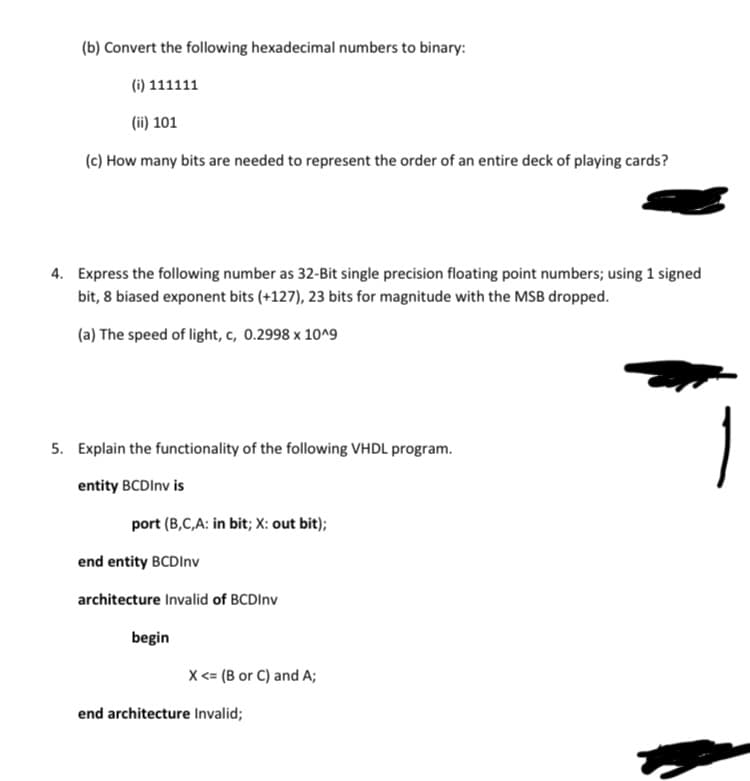(b) Convert the following hexadecimal numbers to binary: (i) 111111 (ii) 101 (c) How many bits are needed to represent the order of an entire deck of playing cards? 4. Express the following number as 32-Bit single precision floating point numbers; using 1 signed bit, 8 biased exponent bits (+127), 23 bits for magnitude with the MSB dropped. (a) The speed of light, c, 0.2998 x 10^9 5. Explain the functionality of the following VHDL program. entity BCDInv is port (B,C,A: in bit; X: out bit); end entity BCDInv architecture Invalid of BCDInv begin X <= (B or C) and A; end architecture Invalid;
(b) Convert the following hexadecimal numbers to binary: (i) 111111 (ii) 101 (c) How many bits are needed to represent the order of an entire deck of playing cards? 4. Express the following number as 32-Bit single precision floating point numbers; using 1 signed bit, 8 biased exponent bits (+127), 23 bits for magnitude with the MSB dropped. (a) The speed of light, c, 0.2998 x 10^9 5. Explain the functionality of the following VHDL program. entity BCDInv is port (B,C,A: in bit; X: out bit); end entity BCDInv architecture Invalid of BCDInv begin X <= (B or C) and A; end architecture Invalid;
Database System Concepts
7th Edition
ISBN:9780078022159
Author:Abraham Silberschatz Professor, Henry F. Korth, S. Sudarshan
Publisher:Abraham Silberschatz Professor, Henry F. Korth, S. Sudarshan
Chapter1: Introduction
Section: Chapter Questions
Problem 1PE
Related questions
Question
100%

Transcribed Image Text:(b) Convert the following hexadecimal numbers to binary:
(i) 111111
(ii) 101
(c) How many bits are needed to represent the order of an entire deck of playing cards?
4. Express the following number as 32-Bit single precision floating point numbers; using 1 signed
bit, 8 biased exponent bits (+127), 23 bits for magnitude with the MSB dropped.
(a) The speed of light, c, 0.2998 x 10^9
5. Explain the functionality of the following VHDL program.
entity BCDInv is
port (B,C,A: in bit; X: out bit);
end entity BCDInv
architecture Invalid of BCDInv
begin
X <= (B or C) and A;
end architecture Invalid;
Expert Solution
This question has been solved!
Explore an expertly crafted, step-by-step solution for a thorough understanding of key concepts.
Step by step
Solved in 2 steps

Knowledge Booster
Learn more about
Need a deep-dive on the concept behind this application? Look no further. Learn more about this topic, computer-science and related others by exploring similar questions and additional content below.Recommended textbooks for you

Database System Concepts
Computer Science
ISBN:
9780078022159
Author:
Abraham Silberschatz Professor, Henry F. Korth, S. Sudarshan
Publisher:
McGraw-Hill Education

Starting Out with Python (4th Edition)
Computer Science
ISBN:
9780134444321
Author:
Tony Gaddis
Publisher:
PEARSON

Digital Fundamentals (11th Edition)
Computer Science
ISBN:
9780132737968
Author:
Thomas L. Floyd
Publisher:
PEARSON

Database System Concepts
Computer Science
ISBN:
9780078022159
Author:
Abraham Silberschatz Professor, Henry F. Korth, S. Sudarshan
Publisher:
McGraw-Hill Education

Starting Out with Python (4th Edition)
Computer Science
ISBN:
9780134444321
Author:
Tony Gaddis
Publisher:
PEARSON

Digital Fundamentals (11th Edition)
Computer Science
ISBN:
9780132737968
Author:
Thomas L. Floyd
Publisher:
PEARSON

C How to Program (8th Edition)
Computer Science
ISBN:
9780133976892
Author:
Paul J. Deitel, Harvey Deitel
Publisher:
PEARSON

Database Systems: Design, Implementation, & Manag…
Computer Science
ISBN:
9781337627900
Author:
Carlos Coronel, Steven Morris
Publisher:
Cengage Learning

Programmable Logic Controllers
Computer Science
ISBN:
9780073373843
Author:
Frank D. Petruzella
Publisher:
McGraw-Hill Education